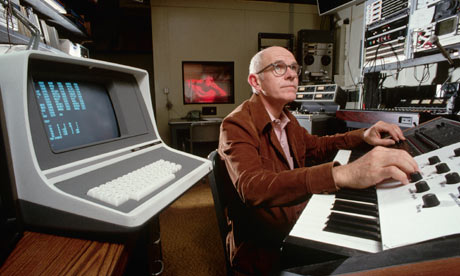
Max Mathews at work at Bell Labs in 1981. A programming music language was named in his honour.
Max Mathews, who has died aged 84, wrote the first computer music program and influenced the conception of HAL 9000, the computer in Stanley Kubrick's film 2001: A Space Odyssey. In the 1968 film, HAL gives a memorable rendering of an old song about a bicycle built for two. This was the result of a series of coincidences.
Mathews had been working on synthetic speech at AT&T's Bell Laboratories, in New Jersey, where a song entitled Daisy Bell had an obvious appeal. The researchers at Bell Labs used their IBM 704 computer and a vocoder (voice synthesiser) to sing it, with Mathews programming the musical accompaniment. Although this was serious research, the output was also used to entertain visitors, including Arthur C Clarke, who used the idea in his novel, and the screenplay, for 2001, in which the astronaut David Bowman shuts HAL down as it sings the song. The scene became part of cinema history and popular culture.
People had been using computers to play tunes for a few years, but Mathews was the first to write a computer music program. He said that "computer performance of music was born in 1957 when an IBM 704 played a 17-second composition on the Music I program, which I wrote". At the time, computers were too slow to play compositions in "real time". It took an hour to create 17 seconds of music. Mathews recorded it to tape and then speeded up the tape to play it back.
He wrote improved versions of his software, up to Music V, which he created "to give the musician the tools to make his own instruments". He also developed Groove, the first computer system for live performance, and Radio Baton, a system for controlling music in standard Midi (musical instrument digital interface) format. Radio Baton used two "wands", prefiguring the sort of controller now used with Nintendo Wii games. Later, Max, a widely used visual programming language for music, was named in his honour.
Mathews was born in Columbus, Nebraska, the son of college teachers. After graduating from high school, he joined the navy, where he trained as a radio technician. He gained a degree in electrical engineering at the California Institute of Technology in 1950, and a doctorate from the Massachusetts Institute of Technology in 1954. He joined Bell Labs, and served as director of its acoustical and behavioural research centre from 1962 to 1985.
While at Bell Labs, Mathews worked with a number of composers, including Edgard Varèse and John Cage, and in the 1970s he helped Pierre Boulez set up the avant-garde Institut de Recherche et Coordination Acoustique/Musique in Paris. He also contributed short pieces to a Bell Labs record, Music from Mathematics, and to Decca's Voice of the Computer: New Musical Horizons.
His paper The Digital Computer As a Musical Instrument was published in the journal Science in 1963. He joined Stanford University's music department as professor of music (research) in 1987, and made San Francisco his home.
During a conference panel on the future of musical instruments at the SF MusicTech Summit in 2010, Mathews said: "When I first got some – I won't call it music – sounds out of a computer in 1957, they were pretty horrible. Almost all the sequence of samples – the sounds that you produce with a digital process – are either uninteresting, or disagreeable, or downright painful and dangerous. It's very hard to find beautiful timbres. A violin may be beautiful but it always will sound like a violin. The computer can sound like anything."
Mathews was a keen amateur violinist and developed a number of electric violins, including one made of sheet metal. One of his instruments appeared on the cover of Playboy magazine's "sex and music" issue in 1998.
Mathews is survived by his wife, Marjorie, their sons, Vernon, Guy and Boyd, and six grandchildren.
• Max Mathews, computer programmer, born 13 November 1926; died 21 April 2011
No comments:
Post a Comment